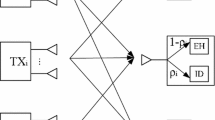Abstract
In this paper, a new method is presented to maximize the minimum achievable rate of the users in a cognitive radio multiple input single output network. The secondary system provides simultaneous wireless information and power transfer (SWIPT) for energy harvesting receivers. Considering random Gaussian vector for the estimation error of the channel state information (CSI), we impose some outage constraints to guarantee the quality of service of the network. Outage constraints on the received power and the information leakage at the energy harvesting users are imposed to assure SWIPT. We introduce new convex inequalities to replace the original non-convex constraints and write the objective function as the minimization of the maximum of some fractional functions. This new objective function and convex inequalities result in a new quasi-convex general fractional programming problem. The new quasi-convex optimization problem is written in such a way that the computational costs to solve this problem are as low as possible. We develop an algorithm to obtain the optimal beamforming weights and artificial noise covariance matrix. All stochastic constraints are rewritten for the special case that the covariance matrices of error in the estimation of CSI are a factor of identity matrix. This reformulation results in less computation costs to obtain optimal beamforming weights and AN covariance matrix. Simulation results confirm that, all stochastic constraints are satisfied with certain probability. In comparison with the previous robust related work, the proposed method achieves higher rates which confirms superiority of our method.





Similar content being viewed by others
References
Varshney, L. R. (2008). Transporting information and energy simultaneously. In IEEE International Symposium on Information Theory (pp. 1612–1616).
Pan, G., Lei, H., Yuan, Y., & Ding, Z. (2017). Performance analysis and optimization for swipt wireless sensor networks. IEEE Transactions on Communications, 65(5), 2291–2302.
Zhao, M. M., Cai, Y., Shi, Q., Hong, M., & Champagne, B. (2017). Joint transceiver designs for full-duplex \(k\) -pair mimo interference channel with swipt. IEEE Transactions on Communications, 65(2), 890–905.
Zhao, N., & Chen, B. (2018). Joint optimization of power splitting and allocation for swipt in interference alignment networks. Physical Communication, 29, 67–77.
Zhang, R., & Ho, C. K. (2013). Mimo broadcasting for simultaneous wireless information and power transfer. IEEE Transactions on Wireless Communications, 12(5), 1989–2001.
Zhou, X., Cai, W., Chen, R., Gui, L., Shu, F., Lin, J., et al. (2018). Secrecy energy efficiency optimization for miso swipt systems. Physical Communication, 28, 19–27.
Xiang, Z., & Tao, M. (2012). Robust beamforming for wireless information and power transmission. IEEE Wireless Communications Letters, 1(4), 372–375.
Le, T. A., Vien, Q. T., Nguyen, H. X., Ng, D. W. K., & Schober, R. (2017). Robust chance-constrained optimization for power-efficient and secure swipt systems. IEEE Transactions on Green Communications and Networking, 1(3), 333–346.
Zhou, X., Zhang, R., & Ho, C. K. (2013). Wireless information and power transfer: Architecture design and rate-energy tradeoff. IEEE Transactions on Communications, 61(11), 4754–4767.
Wen, Z., Li, S., Liu, X., Guo, Z., Xie, Z., & Xiang, W. (2018). Robust downlink beamforming for multiuser swipt systems with imperfect CSI. Journal of Signal Processing Systems, 90, 849–855.
Li, Q., Zhang, Q., & Qin, J. (2015). Optimal probabilistic robust beamforming for miso swipt systems with gaussian channel uncertainties. Wireless Personal Communications, 82, 2407–2415.
Ng, D. W. K., Lo, E. S., & Schober, R. (2016). Multiobjective resource allocation for secure communication in cognitive radio networks with wireless information and power transfer. IEEE Transactions on Vehicular Technology, 65(5), 3166–3184.
Zhou, F., Li, Z., Cheng, J., Li, Q., & Si, J. (2017). Robust an-aided beamforming and power splitting design for secure miso cognitive radio with swipt. IEEE Transactions on Wireless Communications, 16(4), 2450–2464.
Yuan, Y., & Ding, Z. (2018). Outage constrained secrecy rate maximization design with SWIPT in MIMO-CR systems. IEEE Transactions on Vehicular Technology, 67(6), 5475–5480.
Bechar, I. (2009). A bernstein-type inequality for stochastic processes of quadratic forms of gaussian variables. arXiv:0909.3595.
Crouzeix, J. P., & Ferland, J. A. (1991). Algorithms for generalized fractional programming. Mathematical Programming, 52(1), 191–207.
Askari, M., & Vakili, V. T. (2018). Maximizing the minimum achievable rates in cognitive radio networks subject to stochastic constraints. AEU - International Journal of Electronics and Communications, 92, 146–156.
Dinkelbach, W. (1967). On nonlinear fractional programming. Management Science, 13(7), 492–498.
Goemans, M. X., & Williamson, D. P. (1995). Improved approximation algorithms for maximum cut and satisfiability problems using semidefinite programming. Journal of the ACM, 42(6), 1115–1145.
Grant, M., & Boyd, S. (2014). CVX: Matlab software for disciplined convex programming, version 2.1.
Ben-Tal, A., & Nemirovski, A. (2001). Lectures on modern convex optimization. Society for Industrial and Applied Mathematics. https://doi.org/10.1137/1.9780898718829.
Wang, K. Y., So, A. M. C., Chang, T. H., Ma, W. K., & Chi, C. Y. (2014). Outage constrained robust transmit optimization for multiuser miso downlinks: Tractable approximations by conic optimization. IEEE Transactions on Signal Processing, 62(21), 5690–5705.
Author information
Authors and Affiliations
Corresponding author
Additional information
Publisher's Note
Springer Nature remains neutral with regard to jurisdictional claims in published maps and institutional affiliations.
Rights and permissions
About this article
Cite this article
Askari, M., Vakili, V.T. Robust Beamforming and Power Allocation in CR MISO Networks with SWIPT to Maximize the Minimum Achievable Rate. Wireless Pers Commun 106, 927–954 (2019). https://doi.org/10.1007/s11277-019-06197-1
Published:
Issue Date:
DOI: https://doi.org/10.1007/s11277-019-06197-1




